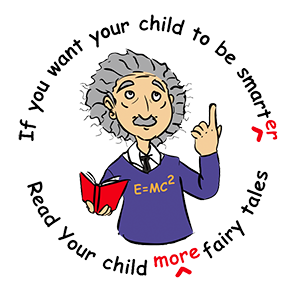Introduction |  To Parents |  To Teachers |  Why Classic Stories Matter |  History of the Project |  Resources |
Why Classic Rhymes and Stories Matter
A rare child might find joy in almost every rhyme and story and picture on the site; some may dislike them all. Given the opportunity, many children will discover they like some rhymes, a few tales, but may find the rest boring, and after dallying with the site a while, will reject these book-like presentations for a movie or tv show or video game that renders them passive by stimulating their senses far more than their minds. God bless them.
Still, we believe—and the research demonstrates—that the more time young children spend with nursery rhymes and classic fables and folk tales and fairy tales, the more efficiently they develop a wide variety of linguistic abilities, the more quickly they become literate, and the more successful they are in school and beyond school.
Since time immemorial, in virtually every human culture, elders have understood how children’s stories powerfully embed fundamental life lessons. This is one reason that the story of the tortoise and the hare (though the animals may differ) is known across the planet. We all deserve to encounter them, and the blind men and the elephant, and the little chicken who thought the sky was falling, and the boy who cried wolf, and the red-hooded girl whom the wolf deceived, and the three little pigs whom he almost devoured. We all need to understand the message of personal responsibility the little red hen represents. No matter how small we are, on the outside or on the inside, we all need to find and nurture in ourselves the kind of courage the little engine discovers when she attempts what seems almost impossible. We all need to know that believing in ourselves and trying our best is often the most important link between “I think I can—" and “I thought I could!" Character matters. Morality matters. And so do the stories by which children learn these important truths.
At our best we adults tend to see through lenses of logic and reason, though these same lenses may leave a child virtually blind, especially in the face of troubling psychological issues. Classic fairy tales enable a child to resolve unspoken fears imaginatively, in ways which transcend and which humble logic and reason. Each classic story shapes itself into a special magic spell which can help heal psychological wounds hidden not only from adults, but too scary sometimes even for a child to acknowledge. Even the most secure children fear abandonment in ways few adults recognize or understand. But Hansel and Gretel understand. And they do suffer. But even so these two children learn to rely on themselves, and manage to persevere and triumph—and they allow every boy and every girl to imaginatively identify with that success. A need to repeat and reinforce that specific kind of imagined success is one reason children need to hear the same story over and over. Cinderella and Jack and the Beanstalk and Sleeping Beauty and Peter Rabbit and Rumplestiltskin and Molly Whuppie target quite different psychological needs, which is one reason each child has favorites, and why—as psychological needs change—a child’s favorites will change.
Classic rhymes and stories:- nurture a wide variety of linguistic skills essential for achieving literacy and provide an invaluable foundation for success in school and beyond;
- provide an opportunity for us to engage our children in a vitally important mental dimension where they are often our superiors: the imagination;
- help embed fundamental lessons of morality and character which have been and are honored by our culture and by virtually all cultures;
- enable all children to resolve normal, yet still profoundly troubling, psychological issues which neither they nor we fully understand.
No one is smart enough to know which stories and rhymes and pictures children need most or how to design them, but generations and generations of children (our own young selves among them) have helped figure out which ones work best. Many of them are on this site. None of us will ever know what all these are worth or, even if we did know, could ever figure out how to pay for them. What they offer children is invaluable. Maybe that’s why they’re free.






